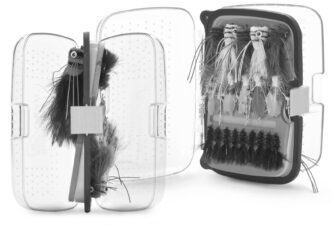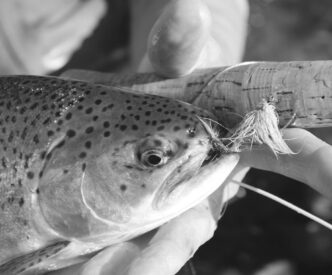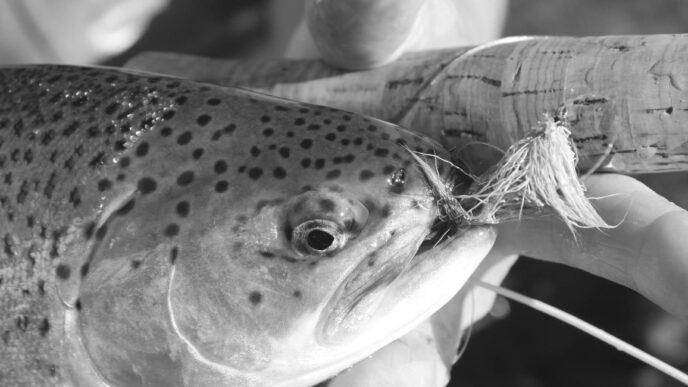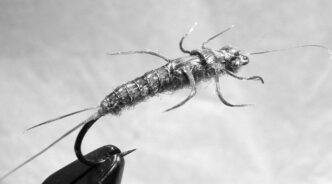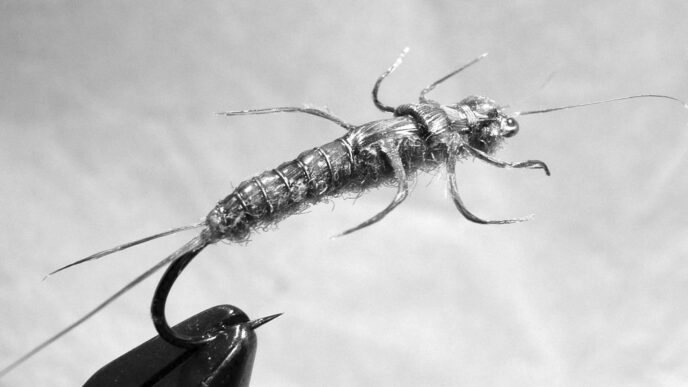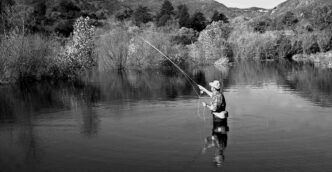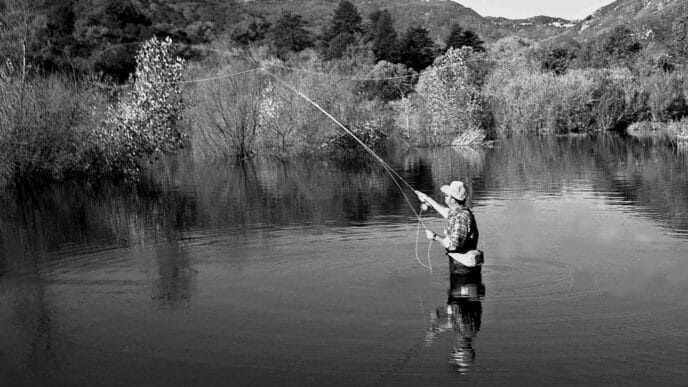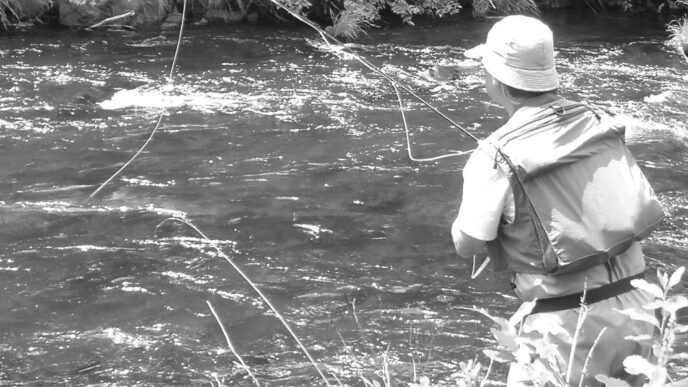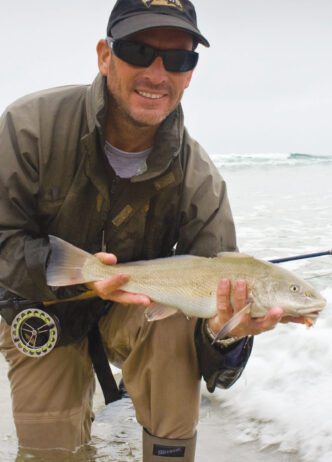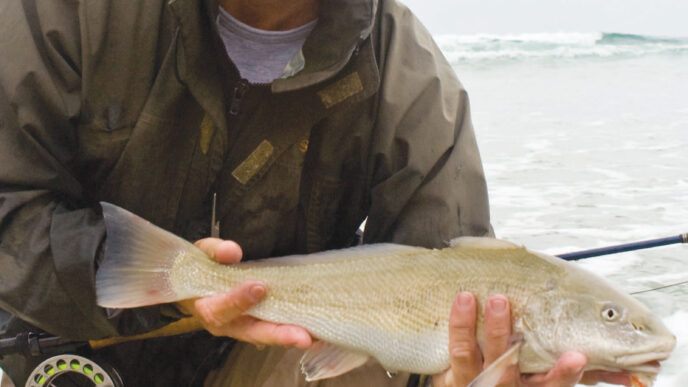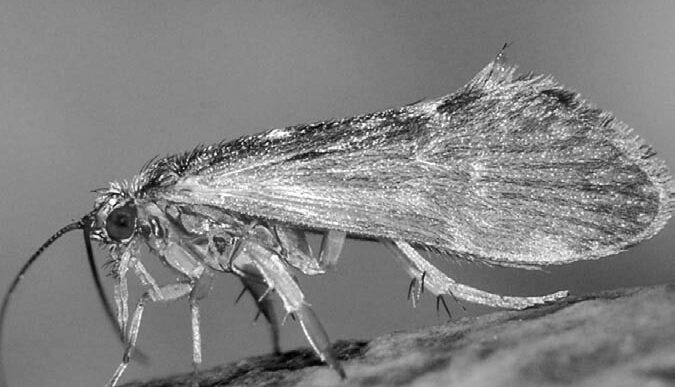Here’s another handful of interesting new products, a couple of which just popped up and a remaining few from last September’s Fly Fishing Retailer show in Denver.
Simms brought a container full of mosquitoes to that show to demonstrate the effectiveness of the Burlington Labs No Fly Zone process that they’ve added to half a dozen new pieces of sportswear. The mosquitoes seemed pretty disinterested in an arm covered with the insect-repellent clothing while readily zoning in on one covered with untreated material. I suppose it’s therefore safe to assume that Simms’s new Bug Blocker Shirt, Fly Away Shirt, and Fly Away Zip-Off Pant (all $89.95), along with three No Fly Zone hats ($29.95 to $39.95), will keep you largely free from bites and buzzing while you do whatever it is you’re doing outdoors. The shirts and pants also make use of Simms COR3 technology for superior moisture wicking, odor prevention, and high UPF ratings. Did I mention that these clothes look good too? (Go to www.simmsfishing.com.)
Railriders, a strong player in the backpack and adventure-travel game, was a new exhibitor at the Fly Fishing Retailer show, with a number of pants, shirts, and shorts that should appeal to anglers. I took a pair of their Adventure Khakis ($59.00) with me on a family vacation to Kauai in December, spent my only fishing time wading a bonefish flat in them in the morning, rinsed them off, let them dry, then wore them to dinner that night at a reasonably upscale restaurant where nobody, including my wife, looked at me any more oddly than they usually do. Sturdily and attractively made from a lightweight, quick-drying, wrinkle-free nylon, they weigh half as much as a pair of cotton khakis, have two side pockets and two zip closing rear pockets, plus belt loops and a little bit of elastic at the waist. (Go to www.railriders.com.)
Fishpond’s Trailhead Rolling Rod/Gear Bag ($299.00) makes a modest start at solving a problem shared by many wheeled duffels, whose heavy basic weight eats significantly into your 50-pound luggage allowance. At just over 8 pounds total weight — lighter by 1 to 3 pounds than many other rollers — you can fit five cased multipiece rods in the zip-open, molded bottom section and a lot of other gear and clothing in the roomy top section and its various inside and outside compartments. The weight is saved by eliminating the telescoping handle. In its place, a strap on the top end of the 35-inch-long Trailhead works just fine for dragging the bag around airports and the like. It’s a fine looking critter, too. (Go to www.fishpondusa.com.)
L. L. Bean’s redesigned Emerger Wading Jacket looks like a winner at the very reasonable price of $79.00. The breathable, waterproof fabric is lighter than the previous version, the gusseted cuffs can be snugged down to keep water out, there are elastic inserts near the shoulders to allow for some stretch while casting, and the visored hood has a functional cord-lock adjustment. Two big chest pockets close with Velcro flaps to which you can fasten ripple-foam fly patches. Both pockets have hidden zinger sleeves, along with reinforced trim at the bottom so you can clip forceps or other tools there without ripping up the fabric. Fleecelined, zipper-closing hand-warmer pockets lie beneath the chest pockets, and while there are no pockets inside, the outside of the left chest pocket sports a waterproof zipper that leads to a small security pocket. The color is a neutral brown-gray that Bean calls “Dark Cement.” (Go to www.llbean.com.)
Cliff’s intruder fly box is designed for stinger-hook steelhead flies. You back the stinger hook into a slot in the foam and trap the head of the fly under a length of memory coil that stretches across the width of the box ($55.95). Cliff’s new Deck Mate ($34.95) is basically a 5.75-by3.5-inch block of slotted foam that attaches to the inside of almost any watercraft via an adhesive backing. Strong magnets on three sides of the Deck Mate hold circular metal “hookers” with rings on them
to which you can attach things such as tippet materials or nippers. You stick your flies into slots in the foam core and pull the ring from the magnet when you need the tippet or tools. And for those of you who feel your vehicle’s upholstery is the place for flies, Cliff has come up with the Headliner Fly Patch ($9.95). It clips to the vehicle’s visor, keeping it free from little holes while still allowing you to display proudly the flies that proclaim you as being ever so hardcore. (Go to www.cliffoutdoors.com)
Scientific Anglers added to their line of waterproof fly boxes, with more models for 2010 ($21.95 to $31.95). All of them make use of the same basic clear-lidded, two-sided, 4.75-by-3.5-by-1.375-inch package, but have different interiors, including a couple with angled inserts that create space for poppers and flies with larger heads. There are also specialty nymph and dry-fly boxes and, in a nod to the more manically organized among us, a molded foam Suitcase ($29.95) designed to store four System X boxes. That’s right, a box for boxes. At 10.5 by 6.5 by 3 inches, it can also serve as a boat box for four kinds or sizes of fly. (Go to www.scientificanglers.com)
The new Pro Guide series of fly boxes from Umpqua Feather Merchants ($24.95 to $39.95) come in small, medium, and large sizes and feature a metal hinged “page” with two-sided, slotted foam fly stations that swing between see-through plastic lids. They’re lightweight and durable, and you can get any size in one of three colors to help keep track of different patterns or styles of fly. (Go to www.umpqua.com.)
Dr. Slick has extended its twisted handle loop concept from hemostats to fly-tying scissors. The idea here is that bending the axis of the loops up from that of the blades reduces muscle fatigue in the fingers, hand, and wrist and improves dexterity. Made from 400-grade stainless steel and available in three useful sizes, they also look cool, with serrated blades and the usual Slick gold color to the loops/handles. (Go to www.drslick.com)
RIO products recently introduced two new types of tippet material. RIO IGFA Tippet is available in 30-yard spools ranging between 2-pound and 30-pound breaking strength. RIO guarantees that this tippet material won’t exceed International Game Fish Association class standards for breaking strength; the price per spool is $4.95. Also new from RIO is their Alloy Hard Saltwater tippet material, which RIO tells us “combines phenomenal abrasion resistance with stiffness to make it . . . ideal for casting the largest of flies and for casting in the toughest of winds — ensuring good turnover in both situations.” Despite its being a “hard” tippet material, RIO says it’s still easy to knot. Thirty-yard spools of 6-pound through 30-pound test retail for $4.95, and “guide spools” of 110 yards in 12-pound, 16-pound, and 20-pound test are available at $12.95 per spool. (Go to www.rioproducts.com.)
RIO also came up with some new tips for Skagit two-handed work, called MOW tips, after the first initials of Skagit maestros Mike McCune, Scott O’Donnell, and Ed Ward. There are three different series of MOW tips, designed for use with three different classes of Skagit heads: lighter than 475 grains, between 475 and 575 grains, and heavier than 575 grains. Each series consists of six tips — five in the same 10-foot length: a floater, a level full-sinking tip, three lines with increasingly longer sinking sections married to a floating butt end — plus a 12.5-foot level full sinker. The idea is to be able to switch tips to fish the entire water column without the length of the head/tip system changing. Heavy MOWs use T-14 in the sinking sections, while Medium and Light MOWs use T-11 and T-8, respectively. You’ll be able to buy the tips individually ($19.95 to $24.95, depending on whether they’re single or dual density) or as a package, for $149.95, that contains all six tips. The Medium and Heavy MOW tips will be available in May, Lights in August. (Go to www.rioproducts.com.)
The Loon Outdoors Shark Tooth Tippet Control System is intended to make cutting off a hunk of tippet material easier. The “system” consists of an elastic strap/loop to which is attached a piece of white plastic into which is set a small, sharp metal blade. To use it, you junk the strap that comes with the tippet spool, wrap on the Shark Tooth strap, feed the tippet through the strap’s eyelet, pull out a length of tippet, rest your thumb on the plastic, pull the tippet across the blade, and, voilà, the tippet, she be cut. This is probably seconds faster and a bit more convenient than using those nippers you’ve got hanging from a zinger. But saving seconds comes at a price, and in the case of the Shark Tooth, the price is $4.95 a tooth. My sense is that the Shark Tooth will be most sensibly used by folks who fish just one or two tippet strengths — striper anglers come to mind, or coastal steelhead and salmon aficionados. The Shark Tooth is available in two sizes to fit the two basic diameters of commercially available tippet spools. (Go to www.loonoutdoors.com.)
Spey-casting adept and instructor Bob Pauli tipped me to a new line that he says is the best he’s ever used. The brainchild of Lee Davison of Snake River Outfitters, the new Ballistic Vector lines fall right in the middle between “short” and “mid-Spey.” The major difference between Vectors and other lines of comparable head length, according to Pauli, is a tip section that turns over very positively, rather than blowing around on distance casts. In a post on Speypages.com, Pauli remarked: “This line is so perfect in its fit for Spey casting it reminds me of the revolution begun by RIO’s introduction of Skagit lines. This is truly an all-day, 90-footcast fishing line without shooting (and obscenely long with shooting).” Vectors will be available in May at about $95.00, but if the kind of performance Pauli describes is for real, price will hardly matter. Vectors are available in five configurations, from a 5/6 with a 390-grain head of 45 feet and a 65-foot running line to a 9/10 with a 650-grain head of 60 feet and a 70-foot running line. (Go to www.snakeriveroutfitters.com.)
Having stumbled through the dark on the way back to camp or my van more times than I can count, I’m now a firm believer in lightweight headlamps. I keep them in my vest, boat bag, and day pack. Petzl, the French headlamp gurus, have improved their category-leading lightweight Tikka models for 2010, increasing output by over 50 percent. The basic Tikka2 model ($29.95) is pretty good, but the new Tikka Plus2 ($39.95) and its big brother the XP2 ($54.95) seem worth the extra money. Both feature white, high-output LEDs for illumination plus red LEDs for closer work that protects night vision. You can use either color in a two or three modes, including a strobe flash for emergencies. The Plus2 and XP2 provide, respectively, 50 and 60 lumens and illumination distances of up to 35 and 60 meters, with maximum burn times in “economic mode” of 140 and 160 hours. Battery-charge indicator lights let you know when output is at dangerously low levels. Both headlamps can withstand immersion in water and can be used with lithium batteries instead of AAAs for increased cold weather performance. (Go to www.petzlusa.com)
And speaking of lights, I’d be remiss to ignore the Lighted Stainless Steel Pliers offered by Streamworks. They are sturdy, well-made, attractive fishing pliers with comfortable rubber grips, a handy holster and tether, and magnetic, rather than spring-closing jaws. What sets them apart from other pliers is a button on the hub that actuates “a long-lasting, sealed white LED [that] focuses a beam of light through the pliers jaws, illuminating the work area.” The pliers themselves look and feel good, the tungsten-carbide jaws are replaceable, and it never hurts to have another flashlight. They’re $139.95. (Go to www.streamworks.com.)



